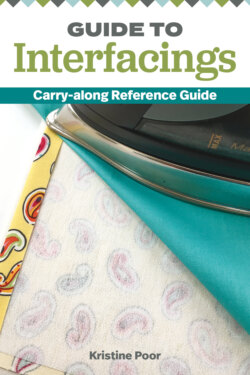Читать книгу Guide to Interfacings - Kristine Poor - Страница 5
ОглавлениеIntroduction
What is interfacing? Interfacing is the layer of fabric between the outer garment or project and the lining or facing. It shapes, supports, and stabilizes. Most projects last longer and look more professional with suitable interfacing.
Choosing and using interfacings properly makes such a difference in the outcome of your project. Use this guide to help you get started in the world of interfacings.
How Do You Choose?
The pattern supply list should serve as a guide to choosing interfacing. It is good to know why a certain interfacing has been recommended, especially when you want to get creative and start using fabrics other than what has been suggested.
There are three main types of interfacing:
1. Woven—This interfacing is produced just like fabric and is generally more durable than a nonwoven.
2. Nonwoven—This type of interfacing is made from polyester fibers bonded together to form a fabric. It will exhibit little or no shrinkage and will not ravel.
3. Knit—This soft interfacing has stretch and can be used with both woven and knit fabrics.
General Tips
TESTING YOUR INTERFACING
Because there are no right or wrong answers when choosing interfacing, it is always best to test before you get started. This will ensure that you get the result that you want.
COLOR
There are dark interfacings as well as light. In some cases when using a dark fabric, light interfacing may show through (and vice versa), so this is something to consider when choosing your interfacing.
DRAPE OR STIFFNESS
There are lightweight to heavyweight interfacings on the market. The more support you need, the stiffer the interfacing. Try this at the store: Lay your fabric over the interfacing—are you getting the result that you want? Try different weights until you are satisfied with your choice.
FUSIBLE VS. SEW-IN APPLICATION
Choosing between a fusible and a sew-in interfacing depends on personal preference, the fabric, and the degree of firmness desired. Fusible interfacing has a layer of heat-activated adhesive that is either printed or sprayed on the interfacing and can be a great time saver. They can also make a fabric slightly crisper than a sew-in interfacing of comparable weight. If you are unsure whether your fabric can be fused, ask the fabric retailer where you purchased the fabric, or if that is not possible, do a test with your fabric and interfacing.
Applying Fusible Interfacing
Always refer to the instructions that come with your interfacing. Use a press cloth when fusing to protect your fashion fabric. It can be a purchased press cloth or a piece of muslin or batiste. Important! Always protect your ironing surface (beneath the project) with parchment paper or a Teflon™ sheet.
For fusible interfacing to be applied to fabric properly, you need to control three things:
■ Time
■ Temperature
■ Pressure
Always PRESS—do not iron in a gliding motion! Fuse from the center then move out to the outer edges. The fusible glue needs time to activate. Press about 10–20 seconds on each section, and then lift and position in the next section, overlapping as you go. Note: Hand-held steamers will not bond interfacing to fabric.
Try this: Use a damp press cloth as a timing tool. The cloth will be dry after 10–20 seconds of fusing. If not, turn up the temperature on the iron and press a little longer.
Let the fabric cool for at least five minutes. Test the bond by attempting to peel the interfacing away from the fabric. The fusible interfacing should be secure. If it isn’t, adjust the time or temperature and test again.
If the result is wrinkly or bubbled, lower the temperature and try again.
If you get no adhesion and notice a shiny surface on the fabric, the glue has transferred to the fabric. Lower the temperature and retest.
Applying Sewn-in Interfacing
Sew a scrap of interfacing to a scrap of the fashion fabric as directed in the project instructions. Use a washable fabric glue stick to temporarily hold the interfacing in place.
When finished, ask yourself the following questions: Is the fabric supported as you would expect? Is the fabric too stiff? Play with different weights to achieve the look that you want.
COMBINATIONS
Sometimes a single interfacing is not enough—you might need a combination of more than one interfacing to achieve the look and function that you need. Make sure that you test beforehand so that you know what to expect when making your project.
Care and Storage
CARE
Be sure to note the care instructions of the interfacings when you purchase them. Select interfacings that require the same care as the project fabric. (Use washable interfacings with washable fabrics; likewise, with dry-clean-only fabrics and interfacings.) If you are unsure of the care instructions for the fabric or the interfacing, wash a test sample to check the results.
To pre-shrink fusible interfacing (and avoid any unwanted results later), fill a sink with warm water (do not add detergent). Soak for about ten minutes. Gently squeeze out excess water by rolling in a clean, dry towel and lay flat to dry.
STORAGE
Fusible interfacing should not be stored for long periods of time; adhesives can be affected by light, moisture, and heat. Make sure to test a sample of older material before use.
Using This Guide
There are so many interfacings available right now that I could not possibly list each one. I listed just a few examples in each category to get you started.
When you find an interfacing that you like to use, keep a sample of it in a notebook, along with the manufacturer’s instructions and the name of the project that you used it on. You’ll be glad you did!
